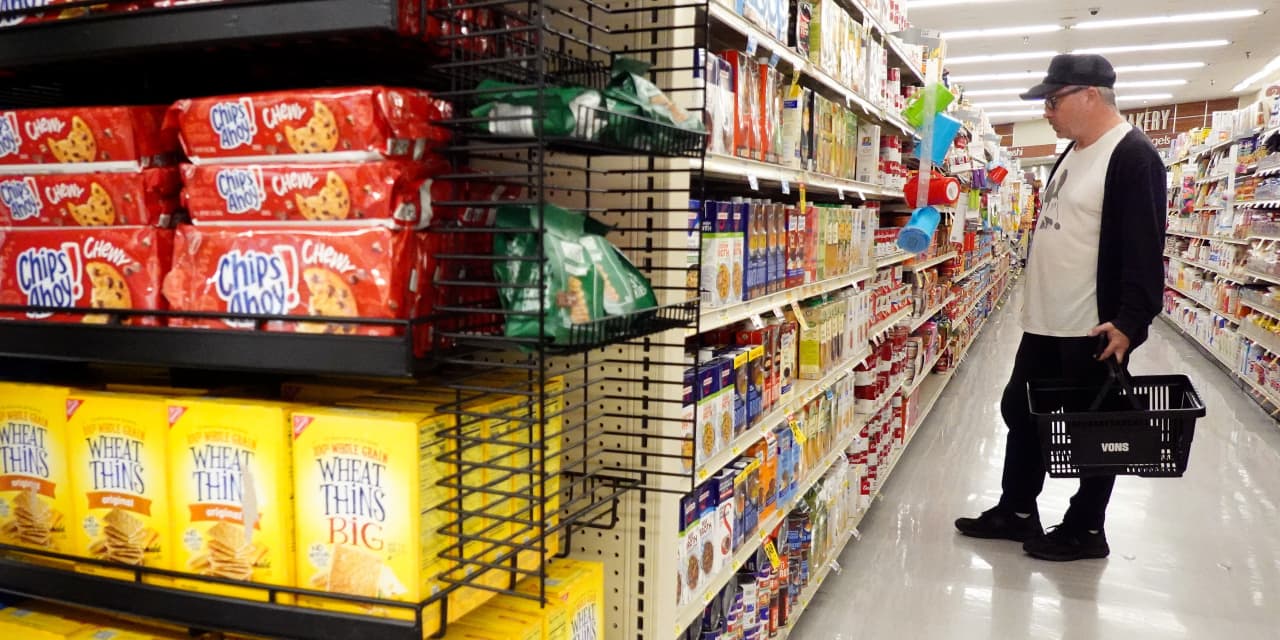Whatever Americans are doing to cope with the high cost of living, it isn’t turning to comfort food.
While inflation’s pace is cooling, prices for many goods and services remain well above where they stood just a few years ago. That’s caused plenty of people to pare down their discretionary budget, to the chagrin of apparel and home goods retailers.
Yet no matter the cost, some purchases are unavoidable. People still have to eat. So why are packaged-food makers selling so much less of their products?
Like an Oreo, the answer has layers.
The pandemic was a great time for packaged-food makers, as everyone turned to their favorite brands and snacked more during their time at home, meaning companies were able to raise prices easily. The market turmoil of 2022 sent investors scurrying for the relatively safe harbor of consumer staples, further bolstering the stocks.
However the tables have turned for the industry, and not for the better. Consumers are balking at higher prices, and have the option to dine out again. This year’s market rally has left little appetite for stodgy staples, particularly as valuations have soared, while yield-hungry investors have plenty of alternatives in a high-interest-rate environment. The upshot is that packaged-food stocks have tumbled this year.
Nonetheless, people are still eating, which makes recent sales volumes declines harder to understand. TD Cowen analyst Robert Moskow argues that there are three main factors behind this trend, which he warns “will continue in 2024 unless the companies take more stringent action to lower price.”
Price is an obvious place to start. Food companies are quick to argue that it’s a broad, systematic problem: With grocery bills so high, consumers are just tightening their belts, literally and metaphorically.
Moskow agrees, to an extent, writing that consumers are “wasting less, resisting impulse purchases, and trading down to cheaper options.”
But that can’t be the whole story, as grocery store volumes are down 1.8% over the past 52 weeks, compared with an average 4.6% decline for big packaged-food companies over that time. Some big players have had it even worse:
Conagra Brands
(ticker: CAG),
General Mills
(GIS),
Kellanova
(K), and
Kraft Heinz
(KHC) have seen their volumes fall 6% or more in the 52-week period ended September 2023.
“Are consumers really eating 1.8% less? We don’t think so,” he writes, arguing that broader weakness only accounts for about half of packaged foods’ volume loss.
He thinks another 40% can be attributed to consumers shifting from packaged food to alternatives such as fresh produce, meat, deli, and bakery products, as these areas of grocery have outperformed.
The final 10%, Moskow believes, is from market-share loss to private label and emerging brands. Not surprisingly, private-label brand sales have continued to climb in 2023, as shoppers keep looking for less-expensive options. Big food companies’ volume growth trailed that of their categories by an average 2.3% over the past 52 weeks, and 0.4% on a four-year compound annual growth rate basis. By Moskow’s math, if they had just maintained their market share, big food companies’ would have grown volumes by 2%.
And that’s before the impact of weight-loss drugs. Moskow writes that he doesn’t see evidence that increased use of GLP-1 drugs for diabetes management and weight-reduction was behind volume declines, although that could add another headache in the long run.
“Volume remains the most important metric on investors’ radar, and we don’t see Big Food company stocks finding a bottom until they stabilize it,” he concludes. “If cooler weather, holiday shopping, and increased merchandising don’t provide a lift, we suspect these companies will need to make bigger price investments to improve their trends.”
There’s also the worry that recent trends aren’t a blip—the pandemic was. In other words, Covid-19 simply offered a brief respite from the longer-term decline in demand for packaged food, in favor of alternatives.
Indeed, out of 17 food stocks in his coverage, Moskow only has Outperform ratings on six:
Freshpet
(FRPT),
Lamb Weston Holdings
(LW),
Mondelez International
(MDLZ),
J.M. Smucker
(SJM),
Hershey
(HSY), and
Utz Brands
(UTZ). That’s not exactly a call for investors to dig in.
Write to Teresa Rivas at teresa.rivas@barrons.com
Read the full article here













Leave a Reply